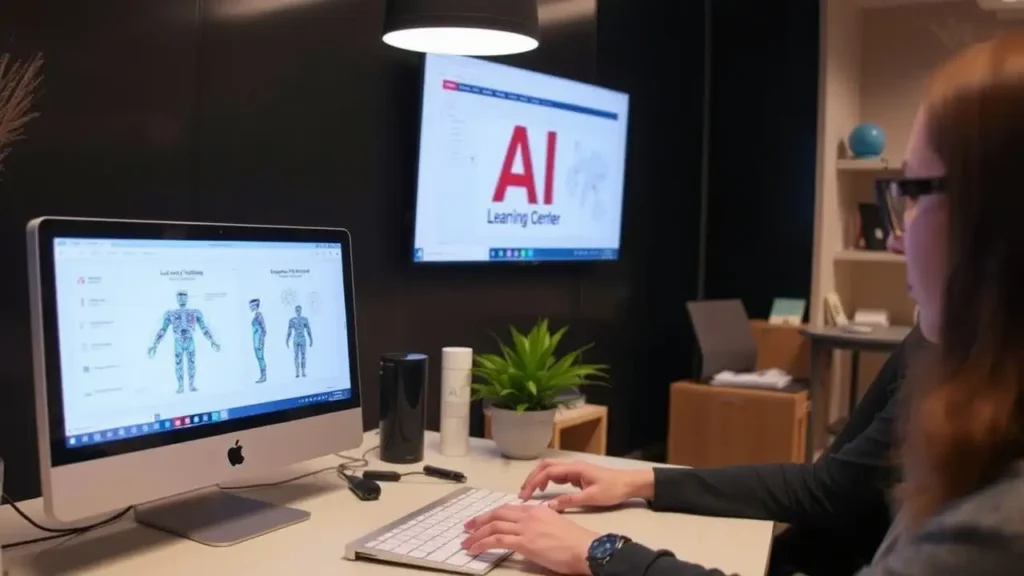Imagine standing at the edge of a digital revolution. Machines are now thinking, learning, and creating. It’s not science fiction; it’s the world of artificial intelligence (AI). It’s changing everything around us.
So, you’d like to know how to learn AI Tools? Here you find your first and complete guide to Artificial intelligence. Remember the first time you used a smartphone? That feeling of wonder and possibility? That’s what learn AI tools feels like today.

AI is everywhere, from your pocket to your home and workplace. It’s in the voice assistant that wakes you up and the algorithm that recommends your next favorite show. AI is becoming a part of our daily lives. And you can be a part of this exciting journey.
This guide is your passport to the world of AI. Whether you’re just starting or looking to improve your skills, we’ll cover the basics of artificial intelligence. You’ll learn about machine learning and deep learning. You’ll see how AI tools are changing industries and opening up new career paths.
Did you know AI engineers earn a median salary of $136,620 a year? Or that jobs in this field are expected to grow by 23% over the next decade? These aren’t just numbers; they’re opportunities waiting for you. So, let’s start this AI learning adventure together, exploring the complexities and using the power of intelligent machines.
Table Of Contents
- 1 Understanding the Fundamentals of Artificial Intelligence
- 2 Types of Artificial Intelligence: From Narrow to General
- 3 The Distinction Between AI, Machine Learning, and Deep Learning
- 4 Essential Prerequisites for Learning AI
- 5 Learn AI Tools: Popular Platforms and Resources
- 6 Practical Applications of AI in Business
- 7 Getting Started with AI Development
- 8 AI Programming Languages and Frameworks
- 9 Building Your AI Learning Path or Learn AI Tools
- 10 AI Tools for Productivity and Workflow
- 11 Career Opportunities in AI
- 12 Best Practices for AI Implementation
- 13 Common Challenges in AI Learning
- 14 Future Trends in AI Technology
- 15 Conclusion
- 16 FAQ About Learn AI Tools
- 16.1 What is artificial intelligence (AI)?
- 16.2 How can I start learning AI?
- 16.3 What are the different types of AI?
- 16.4 What’s the difference between AI, machine learning, and deep learning?
- 16.5 What are some popular AI tools and frameworks?
- 16.6 How is AI applied in business?
- 16.7 What career opportunities are available in AI?
- 16.8 What are the ethical considerations in AI?
- 16.9 What are some common challenges in learning AI?
- 16.10 What are some future trends in AI technology?
Key Takeaways
- AI tools are revolutionizing industries across the board
- Machine learning and deep learning are crucial subsets of AI
- Python is the go-to language for AI development
- AI careers offer high salaries and strong job growth
- Practical AI applications span from chatbots to predictive analytics
- Learning AI provides valuable problem-solving skills
Understanding the Fundamentals of Artificial Intelligence
Artificial Intelligence (AI) is changing the world. It’s making big impacts in many areas of life. To really get it, you need to know what AI is, how it’s evolved, and its main parts.
What Defines Modern AI
AI is about machines doing things like humans do. This includes learning, solving problems, and making choices. You might not even notice it, but AI is all around us, like in virtual assistants and recommendations.
AI uses special algorithms to help it learn and decide. These algorithms are key to how AI works.
The Evolution of AI Technology
AI has been around since the 1950s, thanks to pioneers like Alan Turing. It really took off in the 1990s with better computers. Now, AI is used in many real-world ways.
Key Components of AI Systems
At the heart of AI are intelligent agents. They see their world and act to reach goals. Data and training are also vital, helping AI learn and make choices.
It’s also key to know the difference between Narrow AI and General AI. Narrow AI is good at one thing, while General AI aims to be like humans in many ways.
| AI Component | Function |
|---|---|
| Algorithms | Guide system processing and decision-making |
| Data Sets | Drive learning and improve performance |
| Machine Learning | Enables systems to learn from data |
| Intelligent Agents | Perceive environment and take actions |
Types of Artificial Intelligence: From Narrow to General
AI categories range from simple systems to complex ones. Let’s look at the different types of AI and what they can do.
Narrow AI Applications
Narrow AI, or weak AI, is great at specific tasks. You see it every day in virtual assistants like Siri and Alexa. These systems get better over time thanks to machine learning.
For example, IBM Watson® uses both traditional machine learning and generative AI to help data scientists.
General AI Development
General AI wants to be as smart as humans in many areas. It’s different from narrow AI because it needs to learn from experience. Fujitsu’s K supercomputer is trying to achieve this, but true AGI is still just an idea.
The big challenge is making AI think and feel like humans do.
Superintelligent AI Concepts
Superintelligent AI is still just an idea. It would be smarter than humans in everything. This idea makes us think about self-awareness and what could happen.
Even though it’s interesting, most AI we use today is narrow AI.
| AI Type | Current Status | Examples |
|---|---|---|
| Narrow AI | Widely used | Siri, Alexa, spam filters |
| General AI | Theoretical | Fujitsu’s K supercomputer (attempt) |
| Superintelligent AI | Conceptual | None exist |
As AI gets better, scientists keep trying to make it smarter. Moving from narrow AI to general and superintelligent AI is exciting for the future.
The Distinction Between AI, Machine Learning, and Deep Learning
Many people get confused about AI vs machine learning. AI is about machines acting like humans. Machine learning is a part of AI that teaches computers from data. Deep learning uses special networks to understand complex patterns.
Machine learning has three main types: supervised, unsupervised, and reinforcement learning. Supervised learning uses methods like linear regression. Unsupervised learning, like clustering, works with data without labels. Reinforcement learning, like Q-learning, lets computers learn by doing.
Deep learning is special because it can handle all kinds of data. This is important because most data is unstructured. Neural networks, the heart of deep learning, have layers that help understand data.
| Aspect | AI | Machine Learning | Deep Learning |
|---|---|---|---|
| Scope | Broad concept | Subset of AI | Subset of ML |
| Data Handling | Various types | Structured data | Structured and unstructured |
| Learning Approach | Multiple approaches | Algorithm-based | Neural network-based |
| Human Intervention | Varies | Some required | Minimal required |
It’s important to understand these differences in AI. About 35% of businesses worldwide use AI, and 42% are exploring it. Knowing the difference between AI, machine learning, and deep learning is key.
Essential Prerequisites for Learning AI
Starting your AI journey needs a solid base. The AI prerequisites are the foundation of your learning. They help you understand and use advanced AI solutions.
Mathematical Foundations
Math is key for AI. You must know linear algebra, calculus, and probability well. These subjects are the backbone of AI algorithms. Google’s Machine Learning Crash Course stresses the importance of algebra and linear algebra.
Programming Skills Requirements
Programming is a must for AI. Python is the top choice, followed by R and Java. Knowing NumPy and pandas is crucial. They help you work with data and AI algorithms.
Statistical Knowledge Base
Statistics are vital in AI. Understanding statistics lets you analyze data and make smart decisions. The Google course points out statistics as a crucial AI prerequisite.
| Prerequisite | Importance | Examples |
|---|---|---|
| Mathematics | High | Linear Algebra, Calculus, Probability |
| Programming | Essential | Python, R, Java |
| Statistics | Critical | Data Analysis, Hypothesis Testing |
Focus on these AI prerequisites to lay a strong foundation. Practical experience is crucial. Work on projects, use frameworks like TensorFlow and Keras, and join study groups to improve your skills.
Learn AI Tools: Popular Platforms and Resources
So you can learn AI tools in AI learning platforms that have changed education, offering many AI tools and resources. Online AI courses teach from basic to advanced levels. Let’s look at some top AI resources to start your AI journey.
Google Cloud is a leading AI learning platform. It offers free use of many AI products within monthly limits. For example, the Translation API Basic lets you translate over 100 languages for free, up to 500,000 characters a month.
Amazon Web Services (AWS) also has free AI tools. AWS Polly, Rekognition, Transcribe, and Comprehend have free usage limits.

You can try out different AI features without paying upfront.
| Platform | Free Offering | Benefit |
|---|---|---|
| Google Cloud: Learn AI tools | 500,000 characters/month | Translation across 100+ language pairs |
| AWS Polly: Learn AI tools | 5 million characters/month | Text-to-Speech conversion |
| Google AI Studio: Learn AI tools | Full access | Gemini models for AI deployments |
Google AI Studio is great for those who want to explore the latest in AI. It offers free access to Gemini models and APIs for developers, students, and researchers. It’s perfect for testing and deploying AI ideas.
Keep in mind, these AI tools and courses are just the start. As you learn AI tools more about AI, you’ll find many resources to help you grow in this field.
Practical Applications of AI in Business
AI is changing how businesses work. It helps companies do more with less, making processes smoother and customer service better. Let’s look at some key areas where AI is making a big difference.
AI for Automation
AI is changing routine tasks. Now, 72% of workers use AI every day. It helps with tasks like summarizing reports and writing emails. This lets people focus on more creative and complex work.
Decision Support Systems
AI decision support systems are very helpful for businesses. They look at lots of data to give insights for better decisions. In manufacturing, AI improves quality and saves money.
Customer Service Implementation
AI is making customer service better. Chatbots can understand and talk like humans. This means customers get help that feels personal and fast.
| AI Application | Business Impact | Adoption Rate |
|---|---|---|
| Automation | Increased efficiency in routine tasks | 72% daily use |
| Decision Support | Improved decision-making accuracy | 82% plan to increase investment |
| Customer Service | Enhanced customer satisfaction | Widely adopted across industries |
AI is getting better and its uses in business are growing. It automates tasks, supports better decisions, and improves how we talk to customers. AI is a big change for companies ready to use it.
Getting Started with AI Development
Starting your AI journey can seem overwhelming, but it’s achievable. Begin by learning programming, especially Python. This language is key for all AI projects.
Start with simple projects like a chatbot or image recognition. As you get better, take on more challenging tasks. Remember, the more you practice, the better you’ll get.
| AI Project Level | Example | Skills Developed |
|---|---|---|
| Learn AI tools for Beginner | Chatbot | Natural Language Processing |
| Learn AI tools for intermediate | Image Recognition | Computer Vision |
| Learn AI tools for Advanced | Predictive Analytics | Machine Learning, Data Analysis |
Join online communities like GitHub or Stack Overflow. These places are great for meeting other AI fans. You’ll find lots of help and new ideas.
Keep up with AI news through blogs and social media. This will help you stay current and improve your skills.
“The key to AI development is patience and persistence. Embrace the challenges, and you’ll find the learning process both rewarding and creative.”
Every AI journey is different. Be realistic, ask for help when you need it, and enjoy the learning. With hard work and the right tools, you’ll master AI development.
AI Programming Languages and Frameworks
AI programming languages are key to artificial intelligence. Python is a top choice for AI because it’s easy to learn AI tools and versatile. It’s used in machine learning, computer vision, and natural language processing.
Python for AI Development
Python is great for AI because it’s simple and has a big community. It works well for both newbies and experts.
By 2026, Gartner says 80% of companies will use AI, showing Python’s growing role.
Popular AI Libraries
AI libraries are vital for developers. Python has many, like:
- NumPy for numbers
- Pandas for data
- Scikit-learn AI tools
These libraries make AI work easier.
Development Frameworks
AI frameworks help build AI apps. TensorFlow and PyTorch are top for deep learning. They have tools and parts that speed up work and make it more efficient.
| Language | Key Strengths | AI Applications |
|---|---|---|
| Python | Simplicity, extensive libraries | Machine learning, NLP |
| Java | Security, maintainability | AI agents, business analytics |
| C++ | Speed, efficiency | Robotics, autonomous vehicles |
Knowing these AI languages, libraries, and frameworks is key for AI success.
Building Your AI Learning Path or Learn AI Tools
Creating an AI learning plan is key to growing your AI skills. Begin with math and coding basics. Python is a good start for beginners because it’s easy to learn AI tools and has lots of AI tools.
As you get better, learn AI tools and learn about machine learning and deep learning. These are important for AI.
Learn AI tools, Doing hands-on projects is vital for mastering AI. Try writing your own algorithms and take part in competitions on sites like Kaggle.
This way, you’ll understand AI and build a strong portfolio for your AI career.
Your AI education should include:
- Mathematical foundations (linear algebra, calculus, statistics)
- Programming skills and Learn AI Tools (Python, R)
- Machine learning concepts (learn AI tools concept)
- Deep learning frameworks, learn AI tools (PyTorch, TensorFlow)
- Specializations (computer vision, NLP, reinforcement learning)
To keep up with learn AI tools, follow online courses, read research papers, and join AI groups. Make your learning fit your career goals, whether in data science, machine learning engineering, or AI research.
AI is always changing. So, keep learning and adapting to succeed in your AI career. Be open to new challenges, work with others, and always look for new AI ideas and tools.
AI Tools for Productivity and Workflow
AI tools are changing how we work. A recent survey showed 45% of tech pros find AI tools easier to use. These tools help with tasks like sorting emails and scheduling meetings, so you can focus on important things.
Generative AI Solutions
Generative AI is transforming content creation. Tools like ChatGPT offer free and paid versions, with prices from $20 to $25 per user monthly.
These AI assistants can create marketing materials, product descriptions, and code snippets, saving you time.
Project Management Tools
AI project management tools are key for efficient work. Monday.com and Asana automate tasks, provide visual tracking, and offer AI insights.
They help break down big projects and suggest smart task assignments, great for all levels.
Analytics Platforms
AI analytics tools like Tableau and Power BI turn complex data into useful insights. They create visualizations, suggest questions, and explain results simply. These platforms work with many data sources, perfect for finding trends and making better decisions.
| Tool Category | Example | Key Feature | Pricing (Individual) |
|---|---|---|---|
| Generative AI | ChatGPT | Text generation | $20/month (Plus) |
| Project Management | Monday.com | Task automation | $5-$15/month |
| Analytics | Tableau | Data visualization | Varies |
Using these AI tools can greatly improve your productivity and workflow. It lets you handle more important tasks and lowers the chance of burnout.
Career Opportunities in AI
The AI industry is booming, offering exciting AI careers across various sectors. AI jobs are in high demand, with the US Bureau of Labor Statistics projecting a 26% growth in computer and information research opportunities from 2023 to 2033. This surge in AI industry demand means now is the perfect time to explore AI-related roles.

AI salaries are competitive, reflecting the specialized skills required. Let’s look at some average annual base salaries in the United States:
| AI Career | Average Annual Salary |
|---|---|
| AI/ML Engineer | $121,689 |
| Data Scientist | $116,946 |
| AI Research Scientist | $143,184 |
| Robotics Engineer | $112,163 |
| NLP Engineer | $122,853 |
AI careers span diverse fields like healthcare, finance, and technology. You might find yourself working as an AI engineer, machine learning specialist, or AI researcher.
The field is rapidly evolving, so continuous learning is key to advancing your career.
Emerging roles like AI Ethics Officer and AI Safety Engineer are gaining importance, with salaries ranging from $90,000 to $140,000.
For those aiming high, Chief AI Officer positions can command salaries of $150,000 to over $300,000 annually, depending on the company’s size and sector.
With such promising prospects, exploring a career in AI could be your ticket to a rewarding and lucrative future.
Best Practices for AI Implementation
Implementing AI in your business needs a smart plan. Focus on AI ethics, security, and performance for success. Here are some top tips for using AI responsibly.
Ethical Considerations
AI ethics are key to trust. Make sure your AI is fair and clear. Don’t let biases creep into your data or algorithms. Be ready to explain AI decisions and their effects on users.
Regular checks can keep your AI ethical.
Security Measures
AI security is essential to keep your systems and data safe. Use strong encryption and control who can access your AI. Train your team on how to keep AI secure.
Keep your AI up to date to avoid risks. AI security tools can also help protect your systems.
Performance Optimization
To get the most from AI, focus on quality data and the right algorithms. Make sure your data is clean and ready for AI. Pick AI models that fit your needs.
Keep an eye on your AI’s performance and tweak it as needed. This will make it more accurate and efficient.
Remember, using AI responsibly is a continuous effort. Keep up with AI news and rules. Educate your team on AI. By following these steps, you can use AI effectively while avoiding risks.
| AI Implementation Area | Key Practice | Impact |
|---|---|---|
| Ethics | Regular audits | Builds trust and ensures fairness |
| Security | Encryption and access controls | Protects systems and data |
| Performance | Data quality focus | Improves accuracy and efficiency |
Common Challenges in AI Learning
Starting to learn AI Tools or Starting your AI learning journey is thrilling, but it comes with its own set of challenges. The AI learning curve can be quite steep.
Many people face difficulties along the way. Let’s look at some common challenges and how to overcome them.
One major hurdle is the fast pace of AI advancements. Staying updated requires a lot of effort. To keep up, make it a habit to read AI journals and join online forums.
Mathematical concepts can also be a stumbling block. If you’re finding it tough, break these concepts into smaller parts. Practice often and look for real-world applications to help solidify your knowledge.
AI requires strong programming skills. If your coding skills are lacking, focus on improving them. Online coding bootcamps and hands-on projects are great ways to get better.
| Challenge | Solution |
|---|---|
| Rapidly evolving field | Regular reading of AI journals, joining online communities |
| Complex math concepts | Break down into smaller chunks, practice regularly |
| Extensive programming skills needed | Online coding bootcamps, project-based learning |
Remember, facing and overcoming AI challenges is all part of the learning journey. Stay patient, keep trying, and don’t be afraid to ask for help. With persistence and the right strategy, you’ll master the AI learning curve.
Future Trends in AI Technology
The AI future is changing fast, with new AI technologies changing many industries. AI predictions show a world where AI is part of our daily lives and work.
In 2023, IBM found that 42% of big companies use AI, and 40% are thinking about it. This trend will keep going, with AI making big steps in understanding language, making decisions on its own, and working at the edge of networks.
Generative AI is a big AI prediction. Already, 38% of companies use it, and 42% plan to. This big change will change how we make content, design products, and solve problems in many fields.
| AI Trend | Current Adoption | Potential Impact |
|---|---|---|
| Generative AI | 38% of organizations | Content creation, design, problem-solving |
| AI in Business Automation | 55% of organizations | Increased efficiency, cost reduction |
| AI in Finance | Widespread | Fraud detection, risk assessment, auditing |
| AI in Healthcare | Growing rapidly | Disease identification, drug discovery, patient monitoring |
The future of AI also brings challenges. Employees think AI could do almost a third of their jobs, worrying about losing jobs. Also, AI’s energy use could make a lot of carbon emissions, showing we need to make AI green.
Looking forward, AI’s future is full of promise in many areas. We’ll see new things in AI, science, and health. But we must think about rules and ethics to make sure AI helps everyone.
Conclusion
As you finish your AI learning, it’s clear that knowing AI is key in today’s world. This guide has covered the basics to real-world uses. AI is changing industries fast, making AI skills crucial for growth and innovation.
The future of AI looks bright, with many chances for those who learn AI tools. By learning AI, you’re not just keeping up. You’re leading in tech advancements. Knowing AI well can lead to new opportunities and help you make a difference.
Keep learning or learn AI tools, practicing, and staying curious as you go on your AI journey. The AI world is vast and always changing, with new challenges and discoveries. Your effort in learning AI today will help shape tomorrow’s innovations. Get ready to join the AI revolution!
FAQ About Learn AI Tools
What is artificial intelligence (AI)?
Artificial intelligence is when machines act like humans. They use machine learning and deep learning to do tasks that need human smarts. AI systems look at lots of data, find patterns, and predict outcomes.
How can I start learning AI?
Start learn AI tools by learning math, programming (like Python), and stats. Then, check out online courses and work on projects. Join AI groups too. Make a plan that fits your goals and interests.
What are the different types of AI?
There are three main AI types. Narrow AI is good at one thing. General AI tries to be as smart as humans in many areas. Superintelligent AI is a dream where AI is smarter than humans in everything. Most AI today is narrow AI.
What’s the difference between AI, machine learning, and deep learning?
AI is when machines act like humans. Machine learning is a part of AI that lets computers learn AI tools from data. Deep learning uses many layers to understand complex data.
What are some popular AI tools and frameworks?
TensorFlow, PyTorch, and scikit-learn are top choices for AI. Python is key for AI work, with tools like NumPy and Pandas for data work.
How is AI applied in business?
AI helps businesses in many ways. It automates tasks, supports decisions, and boosts customer service. AI makes work more efficient, cuts down on mistakes, and helps with planning and customer happiness.
What career opportunities are available in AI?
AI offers many jobs with great growth. You can be an AI engineer, machine learning expert, data scientist, or researcher. These jobs are in many fields, like healthcare and finance, with good pay and growth.
What are the ethical considerations in AI?
AI ethics include fairness, transparency, and accountability. It’s important to avoid biases, protect privacy, and think about how AI affects society. Making AI responsibly is key to its trustworthiness.
What are some common challenges in learning AI?
Learning with learn AI Tools can be tough due to their fast pace, complex math, and need for programming skills. To succeed, stay focused, use a structured learning plan, and apply what you learn. Keeping up with new AI trends is also important.
What are some future trends in AI technology?
Future AI will see better natural language processing, autonomous systems, and edge computing. The goal is to make more general AI systems. New tech like quantum computing could change AI a lot.









